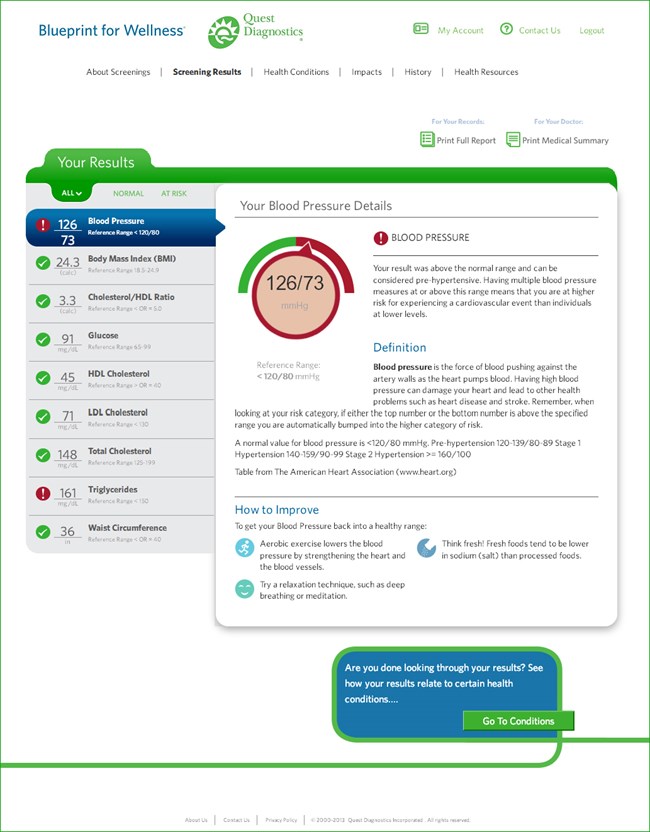A Picture Of Wellness

By Ken Congdon

According to a survey by Towers Watson and the National Business Group on Health, the share of U.S. companies that reward workers for participating in some sort of wellness program grew to 61 percent in 2012 from 36 percent in 2009. Furthermore, The Kaiser Family Foundation reports that nearly half (48 percent) of U.S. companies with more than 200 employees require workers to submit to annual wellness screenings that measure weight, blood pressure, blood sugar, cholesterol, and other health indicators. Corporate investments in these types of screenings are expected to rise this year — the first year where the rules of the Affordable Care Act (ACA) begin to take effect. American businesses hope that engaging in wellness programs and encouraging healthy behavior will help to reduce their overall insurance premiums. However, the jury is still out on whether or not this is a good idea.
Advocates of health screenings and other wellness programs believe these initiatives will be instrumental in illness prevention, which in turn, will lower healthcare costs. This ideology has merit considering nearly three-quarters of U.S. health costs go toward treating chronic conditions and associated complications. There’s no doubt a ton of money could be saved if more Americans were properly motivated to take better care of themselves. However, not everyone believes wellness programs are effective at producing this outcome. Detractors argue that while corporate America has spent more than $2 billion on wellness programs to date, no data exists to prove that these initiatives reduce costs or make people healthier. Furthermore, critics caution that these programs could be used to make sick people pay more for health insurance — a practice the ACA was supposed to prevent.
My Wellness Screening Experience
I’m employed by a small, family-owned publishing company that provides its full-time employees with health insurance. While healthcare reform has certainly placed added pressure on the organization to find affordable healthcare options, the company has yet to invest in wellness programs in an effort to encourage healthy lifestyles and reduce healthcare premiums. However, while attending HIMSS14, I was given a certificate for a complimentary wellness screening by representatives of Quest Diagnostics, a leading provider of diagnostic information services. Quest used this tactic to promote its Blueprint For Wellness program, determined to illustrate the transformative impact health screenings can have on patient behavior and healthcare at large.
The complimentary screening included a series of biometric measures (e.g. height, weight, BMI, blood pressure) and some blood tests to assess glucose, cholesterol, and triglyceride levels. The first step in the process was to log onto the Blueprint For Wellness website, create a personal online account, and schedule a screening appointment at a nearby Quest Diagnostics location. I then went to the lab, had some measurements taken, some blood drawn, and was on my way — easy peasy lemon squeezy.
Two days later, my lab results were uploaded to my online account and ready for me to view. I had so hoped my results would be pristine, so that I could show my readers what a remarkably healthy specimen I am. Unfortunately, that was not to be. Like most folks my age, the tests revealed a few red flags. Specifically, my blood pressure and triglycerides were a bit on the high side.
The results screen for my online Blueprint For Wellness account clearly identified and explained potential health concerns.” (Click image to view full size)
There wasn’t anything special about the health screening itself. On the contrary, the series of tests that were conducted are ones I’ve had done several times before as part of an annual physical exam. However, the way the screening results were presented was truly revolutionary.
Prior to this wellness screening, I had never once seen any of my lab results. Tests were ordered by my PCP, the results were returned to him, and he would call me to communicate the findings. Based on the results, he might suggest a change in diet, more exercise, or in some cases, even a prescription medication. However, all the while, the results were for his eyes only. He may have shown me the results if prodded, but it never really occurred to me to ask. It’s likely the results would have been foreign to me given my lack of medical training. In other words, I wouldn’t know a good LDL cholesterol reading from a bad one without some guidance.
The Blueprint For Wellness screening results, on the other hand, were uploaded directly to my online account. I was personally prompted to view them and react to them. Moreover, the results were presented in such a way that I could easily make sense of the information. Red alert buttons indicate potential health concerns, and gauges illustrate exactly how far outside normal ranges my levels fall. Each test and the associated findings are clearly explained, and several suggestions on how to improve each of my problem areas are included in the results.
This change in information flow is subtle, but it had a profound impact on me. Namely, it made me feel informed, empowered, and more invested in my health. The simple act of putting my health information in my hands made me feel like I was in control. I would still rely on my doctor to be my partner and trusted advisor in shaping my health plan, but I no longer needed to blindly defer to him. Finally, I had the information and tools at my disposal that could prompt me to take action on my own. The name of the program is fitting because the data it generated truly did provide me with a “blueprint” to improve my own health.
So, did my experience convince me that wellness screenings are key to prevention, cost reduction, and ultimately a healthier America? I wouldn’t go that far. I have no way of knowing how health screening information will motivate other patients, if at all. Furthermore, it seems to me that these screenings could actually result in an increased number of tests performed in the U.S. (at least up front). However, I will say this — the access to personal health information provided by these screenings will have a powerful influence on some. It did on me. Plus, the change in information flow can help change the physician/patient dynamic from a one-sided transfer of information from doctor to patient to a more collaborative partnership in health management. I believe health screenings can be instrumental in prompting patient engagement and meaningful conversations with providers. Furthermore, I believe that by placing proper incentives around improving key health metrics can improve patient conditions. All in all, that can’t be a bad thing.

